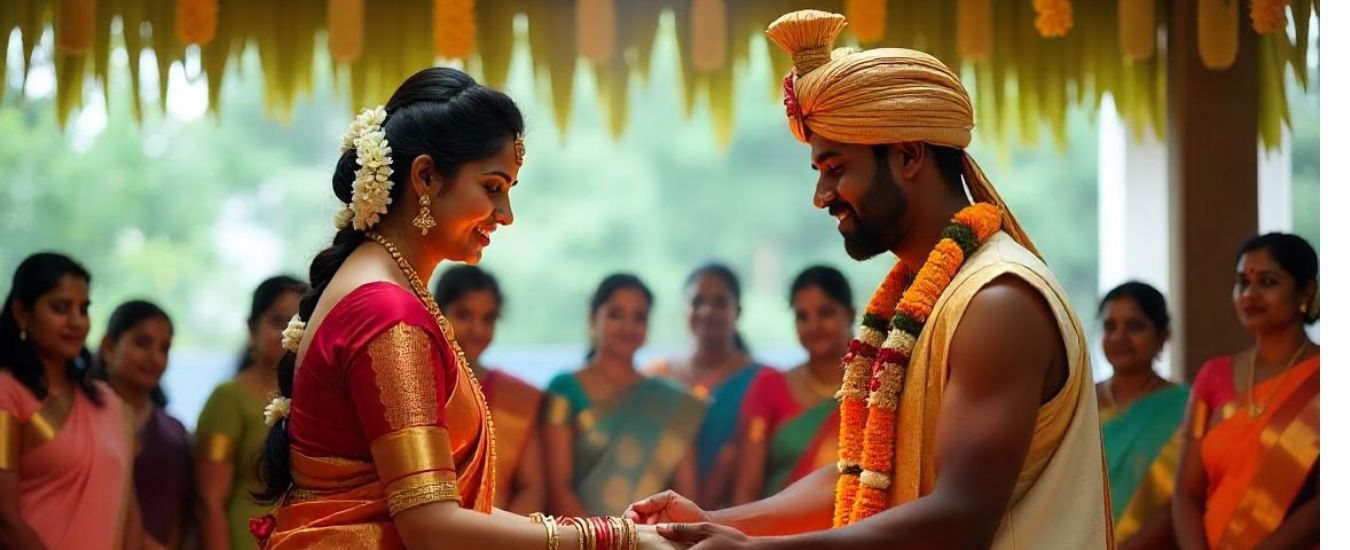From Vedic rituals to soulful music and family traditions to modern expressions, Kannada weddings are timeless cultural celebrations. Whether you’re from the bride’s or groom’s side, you’re bound to leave with memories and meaning.
Weddings in India are a riot of colours, sacred Vedic rituals, and age-old traditions, and Kannada weddings, particularly in Kannadiga households, are no exception. With a perfect blend of simplicity, spiritual depth, and cultural richness, Kannada wedding customs reflect the deep roots of Karnataka’s heritage and South Indian wedding traditions.
Let’s take you on a journey through the soul-stirring rituals and joyful customs that make Kannada Brahmin weddings truly magical.
Why Kannada Weddings Stand Out?
Unlike the extravagant North Indian weddings you see in Bollywood films, Kannada Hindu weddings lean toward spiritual authenticity, gotra-based matchmaking, and Vedic purity. They’re deeply rooted in Hindu dharma yet filled with laughter, music, and unforgettable moments of familial unity.
A Blend of Rituals and Modernity
A Kannada wedding ceremony may start with Punyahavachanam and Sanskrit mantras and end with a DJ night or a Janapada performance — and that’s the beauty of it! They’ve evolved gracefully while retaining sacred roots. It’s the samskara of two souls, families, and lineages.
Pre-Wedding Rituals
Nischay Tamulam (Engagement Ceremony)
Here’s where the magic begins! The betrothal ritual is not just about the couple; it’s about uniting two families. They exchange betel leaves, coconuts, kalasha, and traditional clothes — symbolizing prosperity and purity.
Horoscope Matching and Family Bonding
Kundali matching, gotra alignment, and astrological compatibility play key roles. Once everything aligns, the official “yes” is joyously celebrated.
Naandi Ceremony
The Naandi puja is performed to seek blessings from pitru devatas (ancestors) and deities. A Vedic priest conducts a ritual to eliminate obstacles or doshas ahead.
Kaashi Yatre (also known as Kasi Yatra)
This hilarious yet symbolic ritual sees the groom pretend to become a sanyasi, only to be lovingly stopped by the bride’s father, who offers his daughter’s hand in marriage.
Dev Karya
Before the wedding day, the groom’s side performs a kuladeivam puja, seeking blessings from their family deity at a local temple or shrine.
Kannada Wedding Day Ceremonies
Mandap Decoration and Arrival
The mandapam is adorned with banana stems, mango leaves, marigold flowers, and rangoli designs — invoking divine energy.
Welcoming the Groom’s Family
The groom’s family is welcomed with an aarti, playful teasing, and sometimes a traditional oonjal ceremony (swing ritual) if the family follows it.
Dhare Herdu (Sacred Wedding Ritual)
This core ritual involves the bride’s father pouring sacred water (Dhare) into the groom’s hand, with the bride’s hand on his — symbolizing Kanyadaan and parental consent.
Mangalya Dharane
The groom ties the mangalsutra, often made of black and gold beads, around the bride’s neck with three sacred knots, representing love, fidelity, and shared duty.
Saptapadi (Seven Vows Around the Sacred Fire)
The couple walks around the Agni (sacred fire) seven times, each step representing vows of prosperity, family life, strength, and companionship.
Post-Wedding Rituals
Griha Pravesha
The bride is welcomed into her new home with aarti, rice, and diyas at the entrance — marking her transition into the new household.
Name Change Ceremony
A ritual where the groom gives his bride a new name, which she writes on a plate of rice. This is symbolic and optional in modern contexts.
Reception Party
This modern-day celebration includes themed décor, photo booths, lighting, and lavish vegetarian spreads. Fusion music like Veena–DJ collabs adds to the fun.
Wedding Attire and Jewelry
The Traditional Bridal Look
Kannada brides don Mysore silk or Kanjeevaram sarees, temple jewellery, Gajra-adorned hair, and traditional gold waist belts (Vaddanam).
The Groom’s Attire
Grooms typically wear a white veshti (dhoti), angavastram, and a pheta (turban) — minimalist yet regal.
Food and Festivities
Pure Vegetarian Wedding Feast
Meals are served on banana leaves, with items like bisibelebath, kosambari, huli, rasam, pongal, payasam, and obbattu — echoing Udupi cuisine traditions.
Music and Cultural Performances
Expect Carnatic music, Nadaswaram, and occasionally Dollu Kunitha or Yakshagana performances. It’s a mix of folk and classical vibrancy.
Deep Cultural Significance
Each ritual affirms values of humility, dharma, family bonding, and respect for elders. Kannada weddings are a living expression of Karnataka’s spiritual and social ethos.
Evolving Wedding Trends
From eco-friendly weddings and digital invites to destination weddings in Coorg or Chikmagalur, Kannada ceremonies are adapting without compromising their soul.
FAQs
How long does a typical Kannada wedding last?
A Kannada wedding usually spans 2–3 days, including pre-wedding, wedding, and post-wedding rituals.
What is the significance of the mangalsutra in Kannada weddings?
The mangalsutra is a sacred necklace that symbolizes marital commitment, love, and protection.
Are Kannada weddings always traditional, or do they allow modern elements?
While the core rituals remain traditional, many couples now include modern twists like themed décor, fusion music, and destination venues.
Is food vegetarian in Kannada weddings?
Yes, traditionally, the wedding feast is completely vegetarian and served on banana leaves.
What’s the most unique ritual in a Kannada wedding?
The Kaashi Yatra is a standout — it adds humour and drama, making it a crowd favourite!
